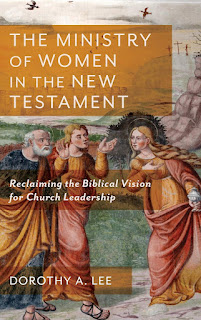The Ministry of Women in the New Testament
Part 1: Women's Ministry in the New Testament
1. Mark and Matthew
2. Gospel of Luke
3. Acts
4. Gospel of John
5. Paul's Letters: Historical and Thematic Issues
6. Paul's Letters: Key Texts
7. Later New Testament Writings
Part 2: Women's Ministry in the Tradition
8. History and Texts
9. Theology
She combs through each book and letter and includes helpful charts detailing each woman (named and unnamed). Having it all laid out made it easy to see the impressive contributions of women. An important point was to challenge the unconscious bias many of us have when we hear the term disciples. Her continual refrain was to remind us that, unless it was explicitly just the 12 disciples, we should assume women were part of the group. From movies to flannelgraphs women are rarely visually included among the numerous followers and how we consume those images can impact our later reading of the texts.
This is a deeply scholarly read (over 600 endnotes!) diving into issues of textual criticism as well as theories on authorship and source material like Q. It may not be the best resource for a casual reader but it is not over the head of someone with a basic familiarity of Biblical criticism or those willing to dive deeper.
I particularly appreciated the last chapter covering the contributions women made to theology during the unfortunately named Patristic period. In seminary I am currently studying Theology 1 and having this resource alongside my textbooks has enabled me to see the hidden women who have been obscured in favor of the early church fathers.
Her fire burned brightest in the conclusion as she gave a passionate defense for the full inclusion of women in every aspect of ministry, lay and ordained. I hold to a generous complementarian theology and I did not agree with all of her conclusions. She made strong arguments regarding how feminine imagery such as mothering complements the androcentric language for God and challenges assumptions. Another area of strength was in pointing out the inaccuracy of translating 'adelphoi' as simply 'brothers' instead of a more accurate and inclusive term. However, one argument I thought was a bit overstretched centered on the household codes. She argued that authority structures within marriage were null and void. "Because slavery is now universally opposed we ought by definition to oppose the other." However, she did not mention the other group commonly found in those codes, parents and children and did not argue for the abolition of parental authority on the same principal.
Nevertheless, the entirety of the book was so compelling to the case that women's ministry need not be limited as much as it is now. No matter your views on the roles of women in ministry, I'd recommend it as an excellent resource in order to see the fuller picture of how women engaged in ministry roles in the first century.
I received an advance copy of this book from the publisher. All opinions are my own.



Comments